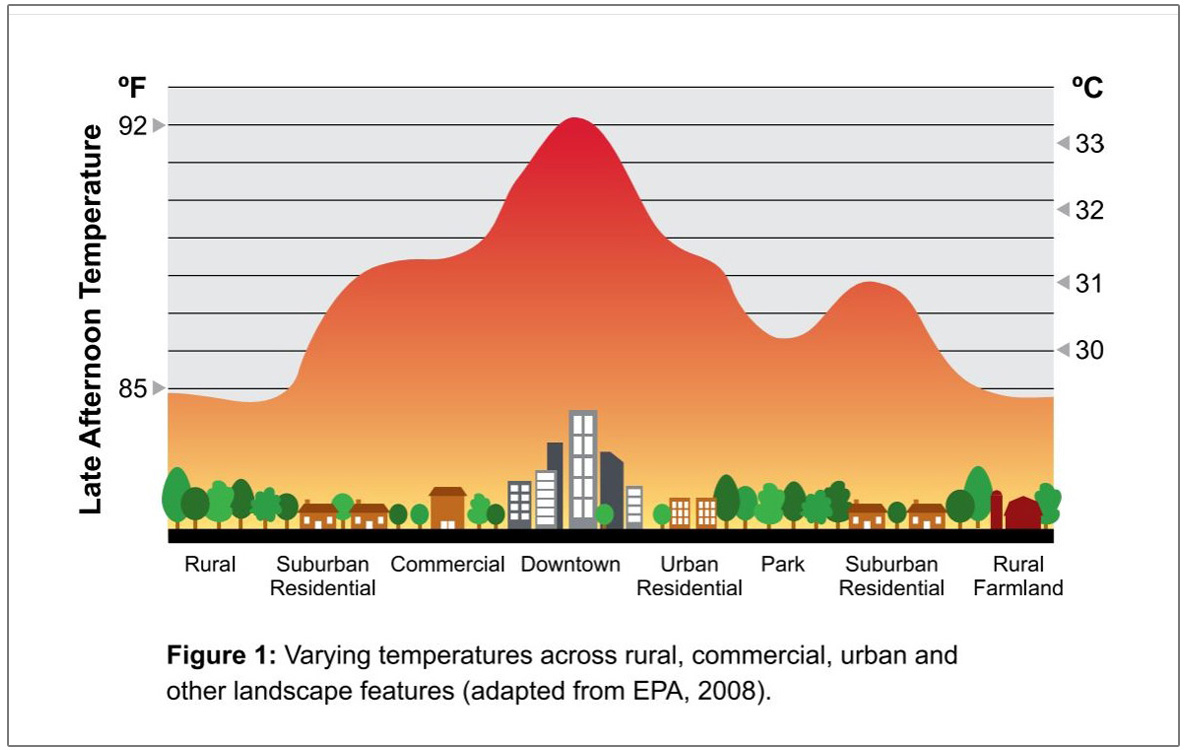Shade trees also play a vital role in combating climate change
Dense urban areas like Hoboken get hotter than suburban and rural areas. The sun heats up the hard surfaces of the brick, glass, concrete and asphalt. These structures absorb and reflect the heat of the sun during the day and radiate the heat throughout the night. People retreat inside their homes, offices and cars to crank up their air conditioners, emitting yet more hot air outside. This is known as the heat island effect which is exacerbated with larger buildings and fewer parks and shade trees. The extreme temperatures of this summer are setting new records. Since 2005, climate change has resulted in the ten hottest days on record, making the need to address this problem ever more urgent.
Shade trees are a critical component of a city’s infrastructure. Through photosynthesis, shade trees sequester carbon dioxide and provide oxygen, essential to human life. Large trees also have the capacity to take up significant volumes of water, thus reducing storm-water runoff. They also are able to remove pollutants from the air, including carbon monoxide, nitrogen dioxide, sulfur dioxide and particulate matter, thus improving air quality and creating a healthier environment. Trees contribute significantly to the energy efficiency of buildings. Huge London Plane trees in Hoboken’s oldest parks are over 100 years old, demonstrating the long-lasting, economical benefits of investing in shade trees.
A recent research project by a Korean professor studied the relationship between green space and citizen happiness by analyzing data from satellite images of sixty different countries. The analysis focused on cities with the highest population densities. In all the cities, citizen happiness was positively correlated with the area of urban green space. Greater areas of green space were a more important factor than economic growth. An article about this study in the Science Daily stated, “Urban green space, including parks, gardens, and riversides not only provides aesthetic pleasure, but also positively affects our health by promoting physical activity and social interaction.“
Parks and public open space bring people together. Parks are for concerts, recreation, community events and a myriad of other activities that build a sense of community. As more of Hoboken’s waterfront park is built, it ties the community together, providing the opportunity to connect with others enjoying the linear nature of this open space. The many emotional and physical health benefits of parks and open green space is well documented. A number of studies are cited in our article from five years ago, “Public parks provide essential benefits for urban dwellers, especially those in need.” (See link below.)
In Hoboken, the best place to escape the summer heat is at the park along the South Waterfront. Hundreds of closely spaced shade trees planted in the late 1990s now form a dense canopy. In the dog days of summer, these trees block the unrelenting rays of the sun as cooling breezes flow in from the New York Harbor and Hudson River. Extending the rows of shade trees at the South Waterfront to the north, through the central waterfront and completing the missing links in the continuous park at the water’s edge, would make Hoboken a model for riverfront development.
Related Links
With rows of shade trees, Hoboken’s South Waterfront is a model for trees in urban design
Landscape design for Columbus Park still shines 108 years later
The morning after Superstorm Sandy: Hoboken’s waterfront parks
Public parks provide essential benefits
Col. Stevens vision for Hoboken still valid 200 years later
Editorial: A Once-in-a-century Opportunity
Plan for the Hoboken Waterfont
Hoboken’s first parks established in 1804
Roots over the river


